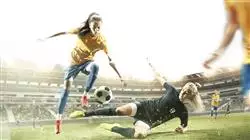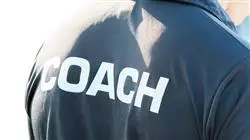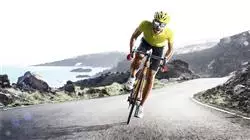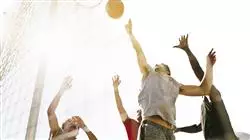University certificate
Scientific endorser

The world's largest faculty of sports science”
Description
You will analyze the sport from a global framework, as well as the agreements and declarations that come into play and have an impact on your professional activity"

Today, the sports system has a double dimension, It is based on the collaboration of the public and private spheres. While institutions such as the Superior Sports Council are of state competence, professional leagues, the Olympic Committee or the various federations belong to the other sector. This makes the interrelationship between all organisms even more complex.
Therefore, this TECH program is positioned as an opportunity for athletes and other sports science professionals to examine the functioning, composition or competencies of each of the sports institutions. However, the program also provides the other side, emphasizing the legal and labor regime of the figure of the elite and amateur athlete.
With this extensive specialization, they will be fluent in all the legal aspects that concern their activity, determining actions on the part of organizations or entities that are not in accordance with the law. This will undoubtedly play in your favor when it comes to asserting your rights or advising other athletes.
Thus, with only an Internet connection, the student will be able to develop in this area. And it will do so with guarantees, with a solid teaching team that will remain at your disposal and with the largest catalog of virtual resources that has been developed in this field.
Thanks to this program you will be able to determine the role of the different actors of sport in the prevention of violence in sporting events"
This Postgraduate diploma in Sports Organization contains the most complete and up-to-date scientific program on the market. The most important features include:
- The development of practical cases presented by experts in Sports Organization
- The graphic, schematic and eminently practical contents of the book provide legal and practical information on those disciplines that are essential for professional practice
- Practical exercises where self-assessment can be used to improve learning
- Its special emphasis on innovative methodologies
- Theoretical lessons, questions for experts, discussion forums on controversial issues and individual reflection work
- Content that is accessible from any fixed or portable device with an Internet connection
Are you looking for an updated knowledge of the organization and range of competencies of professional leagues? This is the program for you!"
The program’s teaching staff includes professionals in the sector who contribute their work experience to this training program, as well as renowned specialists from leading societies and prestigious universities.
Its multimedia content, developed with the latest educational technology, will provide the professional with situated and contextual learning, i.e., a simulated environment that will provide an immersive education programmed to learn in real situations.
The design of this program focuses on Problem-Based Learning, by means of which the professional must try to solve the different professional practice situations that are presented throughout the academic course. For this purpose, students will be assisted by an innovative interactive video system developed by renowned experts.
You will delve into essential aspects of the organization of sport, such as the decisive role of public-private collaboration and its current approach"

Through the analysis of advanced case studies, you will examine the actions that favor non-discrimination in the field of sports, with a focus on equality plans and women's sports"
Syllabus
The design of the syllabus of the Postgraduate diploma contains all the keys that provide students with a comprehensive view of the organization and legal regime of sport, focusing in turn on the sports entities and the figure of the athlete. Throughout 450 hours, the student will examine the different concepts of the syllabus in a very dynamic way thanks to discussion forums, case studies, videos or interactive summaries.

A curriculum that will allow you to analyze at length the competitive and organizational differences between professional and municipal sports"
Module 1. Organization of Sports and its Legal Regime
1.1. Sport in a global context
1.1.1. Sport and International Law
1.1.2. Conventions and declarations in relation to sports
1.1.3. International sports organizations
1.2. Legal system of sport I
1.2.1. Constitutional framework for sport
1.2.2. The Legal System of Sport
1.2.3. Main novelties of the new Sports Law
1.3. Legal system of sport II
1.3.1. Sports federations
1.3.2. Sports Corporations
1.3.3. Health prevention in sports
1.3.4. Prevention of violence in sporting events
1.3.5. Sports discipline
1.4. Sports organization I
1.4.1. The sports model
1.4.2. Superior Sports Council (SSC)
1.4.3. The Olympic Committee and the Paralympic Committee
1.4.3. General Sports Assembly
1.5. Sports organization II
1.5.1. International federations
1.5.2. Sports federations
1.5.3. Autonomous or territorial sports federations
1.6. Sports organization III
1.6.1. Administrative Court of Sport
1.6.2. State Commission against Violence, Racism, Xenophobia and Intolerance in Sports
1.6.3. Other bodies
1.7. Professional leagues
1.7.1. Characters
1.7.2. Organization
1.7.3. Skills
1.8. Public private collaboration in sports
1.8.1. Approach
1.8.2. OSA Program (Olympic Sports Association)
1.8.3. APTA Plan (Aid to Paralympic Target Athletes)
1.9. Development of Sport in the Derived Competencies
1.9.1. Skills
1.9.2. Organization
1.9.3. Successful initiatives and experiences
1.10. Municipal competitions. Municipal sports
1.10.1. Skills
1.10.2. Organization
1.10.3. Successful initiatives and experiences
Module 2. Legal Regime of Sports Entities
2.1. Sports federations
2.1.1. The federated pyramid system. Conceptual approach
2.1.2. International sports federations:
2.1.2.1. Concept, legal regime, functions and other notes of practical importance
2.1.3. State sports federations:
2.1.3.1. Concept, legal regime, functions and other relevant details
2.1.4. Documentary and accounting aspects
2.2. Sports clubs
2.2.1. Contextualization
2.2.2. State legal framework
2.2.3. Types of sports clubs
2.2.4. Constitution, organizational structure, functions , and issues of practical relevance
2.3. Anonymous Sports Societies (ASS)
2.3.1. State legal framework
2.3.2. Theoretical and practical characteristics of ODSs
2.3.3. Differences between sports clubs and SAD
2.4. Professional leagues
2.4.1. Regulatory Framework
2.4.2. Concept, internal structure and functions
2.4.3. Coordination between professional leagues and sports federations
2.4.4. Notes on television broadcasting rights
2.5. Olympic Committee
2.5.1. The Olympic Committee
2.5.2. International Olympic Committee
2.5.3. Other international organizations linked to the sports sector
2.6. Superior Sports Council
2.6.1. Regulatory and jurisdictional framework
2.6.2. Concept and organizational structure
2.6.3. Practical issues in grant management
2.7. Non-federated sports system
2.7.1. The cases of paddle tennis and golf: World Padel Tour and Live Golf
2.7.2. Basketball: Euroleague Commercial Assets
2.7.3. Matching federated and non-federated sports
2.7.4. Reference to the contracts of individual professional athletes
2.8. Administrative Court of Sport
2.8.1. Regulatory Framework
2.8.2. Concept, structure and functions
2.8.3. Procedure
2.9. Court of Arbitration for Sport (CAS)
2.9.1. Regulatory Framework
2.9.2. Concept, structure and functions
2.9.3. Procedures
2.10. Foundations
2.10.1. Regulatory Framework
2.10.2. Concept, internal structure
2.10.3. The figure of the sports volunteer
2.10.4. Other examples of “sports foundations”
Module 3. Labor Law Regime for Professional and Amateur Sportsmen and Sportswomen
3.1. The employment relationship of professional athletes
3.1.1. Background: the process of laborization of professional sportsmen and women
3.1.2. The legal regime applicable to the employment relationship of professional athletes: sources of its regulation
3.1.3. Sports law regulations applicable to the employment relationship of professional athletes
3.1.4. Exclusions
3.2. The athlete with non-professional or amateur sports
3.2.1. Professional vs non-professional (amateur) athlete
3.2.2. Notes on the employment relationship of the professional athlete
3.2.3. Volunteering as a non-labor form of providing services for non-profit sports organizations
3.2.4. Peculiarities of the e-Sports employment relationship
3.3. The employment contract of professional athletes
3.3.1. The subjects of the employment relationship in professional sports
3.3.2. The delimitation of the employment contract from other related concepts
3.3.3. The ability to be contracted by a club or sporting entity
3.3.3.1. The age of the professional athlete
3.3.3.2. Nationality
3.3.4. The capacity to contract as a professional athlete:
3.3.4.1. Working age
3.3.4.2. The federative license
3.3.5. Limits to employment contracts of sports clubs and organizations
3.3.6. Preliminary agreements in the sports employment contract: the pre-contract and the promise of contract
3.4. Formalization of the Athletes’ Employment Contract: Temporary nature and types of contracts
3.4.1. The form of the employment contract of professional athletes
3.4.2. Mandatory minimum content of the contract
3.4.3. Temporariness as a “natural” characteristic of the employment contract of professional athletes
3.4.4. Contractual modalities in the contract of the professional athletes
3.4.5. Extension of the contract and retention rights
3.4.6. The Probationary Period
3.4.7. Compensation for termination of the contract
3.5. The determination of the professional athlete’s employment relationship: classification and working time
3.5.1. Professional classification
3.5.2. Working and resting time:
3.5.2.1. The professional athlete’s journey
3.5.2.2. Weekly rest
3.5.2.3. Labor Holidays
3.5.2.4. Vacations for professional athletes
3.5.2.5. Paid leave
3.5.3. The determination of the employment relationship of the professional athlete in collective bargaining
3.6. The salary of the professional athlete
3.6.1. The concept of salary and non-wage compensation
3.6.2. The salary structure of professional athletes
3.6.3. Determination of wages: amount and payment of wages
3.6.4. Protecting the salaries of professional athletes
3.7. Rights and duties of professional athletes and their contracting entities
3.7.1. The duty of care and the performance required of the professional athlete
3.7.2. Fundamental rights: freedom of expression of the professional athlete
3.7.3. Athletes’ image rights
3.7.4. The Right to Effective Occupancy
3.7.5. Athletes’ collective rights: collective representation rights, the right to strike and collective bargaining
3.7.6. Other rights and duties of athletes
3.7.7. The protection of the labor rights of professional athletes
3.7.8. Occupational health protection for professional athletes
3.8. Vicissitudes of the employment relationship of professional sportsmen and women
3.8.1. Functional Mobility
3.8.2. Changes in working conditions
3.8.3. International mobility of professional athletes and the applicable legal regime
3.8.4. Suspension of the employment relationship
3.8.5. Temporary assignment of the athlete
3.8.6. The transfer of the club or sporting entity
3.9. Disciplinary regime and dismissal of the professional athlete
3.9.1. Disciplinary regime for professional athletes
3.9.2. Dismissal of professional athletes
3.9.3. Protection against dismissal for professional athletes
3.10. Termination of the employment relationship of the professional athlete
3.10.1. Causes of extinction: general enumeration of causes
3.10.2. Causes attributable to the professional athlete
3.10.3. Causes attributable to the club or sporting entity
3.10.4. Termination of the employment relationship at the will of the professional athlete

If your professional activity requires you to keep up to date with the latest developments in sportsmen's contracts, this syllabus will enable you to examine all their elements and preliminary agreements, such as the pre-contract or the promise to hire"
Postgraduate Diploma in Sport Organization
.
Sport organization is a constantly evolving field of study, focused on addressing the management and administration of different sport and athletic activities at the organizational level. The Postgraduate Diploma in Sport Organization created by TECH Global University, offers an in-depth understanding of the principles and practices that govern sport management worldwide. The Postgraduate Diploma is taught in virtual mode and has an innovative educational scheme that will provide you with the latest tools on the market. The contents proposed in the curriculum range from strategic planning, financial management, sports marketing, event management and sports governance, to current trends in the sports industry and how they affect professionals in the sector.
Specialize in the organization of sport
.
This Postgraduate Diploma was designed by the best specialists in the field, thanks to this, you will have the possibility to access an innovative curriculum, with updated thematic axes that will enhance your knowledge and skills. Throughout the training, you will learn about the dynamics of sports organizations, including leagues, teams and sports federations; you will also understand how these organizations relate to athletes, coaches and the general public. You will also delve into the policies and regulations that govern sport management and how organizations must implement them to achieve success in their processes. Thanks to our innovative approach, you will be empowered to meet the challenges of the sport sector and make a significant contribution to your organization.







